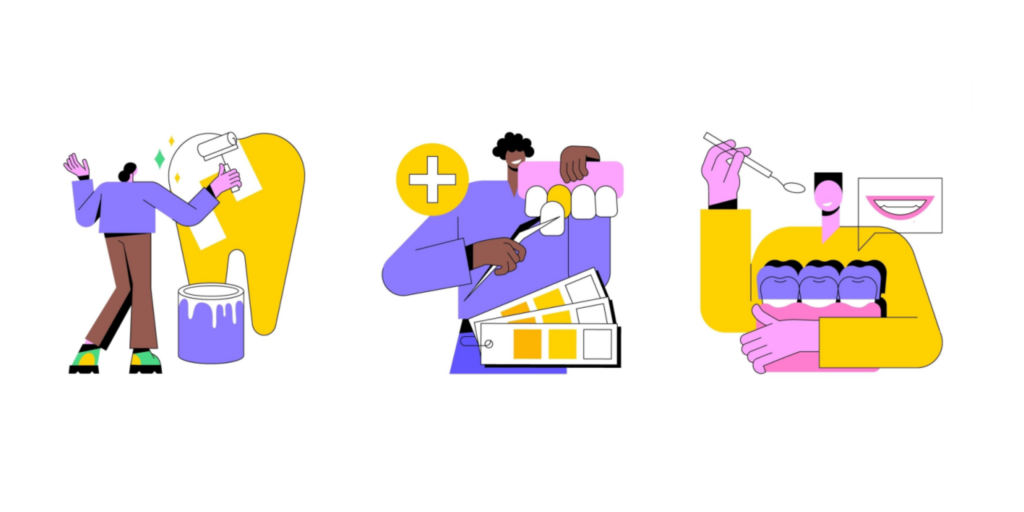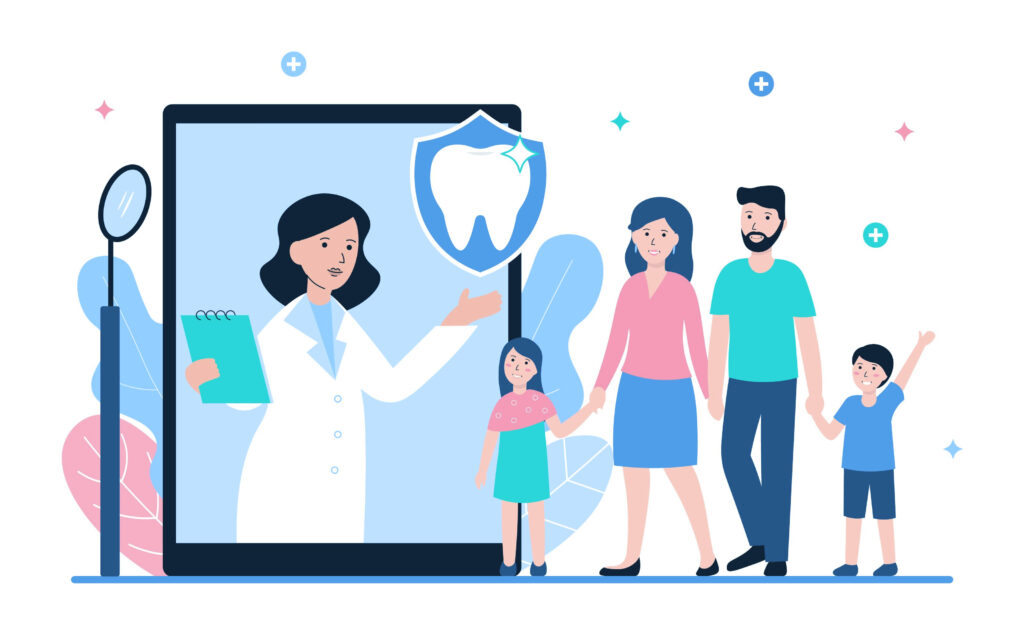Last updated on May 25th, 2022 at 02:29 pm
 A question I get a lot (and for good reason) is, “How do I get more new patients?”
A question I get a lot (and for good reason) is, “How do I get more new patients?”
And while many factors play into this, I would have to say that the easiest (and cheapest) way to get more high-quality new patients is…get ready for it, it’s a no-brainer: getting your patients to refer their friends and family!
So, whenever I’m asked new patient related questions, the first thing I ask is: are you really emphasizing referrals in your practice?
In the innumerable conversations I’ve had with dentists that were desperate for ideas on how to get more new patients, the discussion almost always begins with questions about costly marketing options. “How much direct mail should I send out?” “What about Google AdWords?” and so it goes. And while they all should be doing a coordinated campaign of external marketing, I rarely, if ever find that any are making a serious effort to get more referrals. They want to expend all this energy on these external options. And again that’s fine. But, why not also expend that energy to get more referrals? Referral programs are virtually free—or cost very little to run and referrals generally turn out to be the best patients!
(Related: 3 Ways to Get More New Patient Referrals)
At MGE one of the internal marketing tools that we use to increase referrals is the Care-to-Share Program. In case you aren’t familiar with this program, here are the broad strokes:
You give your patients referral cards to give to their friends and family. This card features a new patient discount (e.g., a free exam and cleaning or $100 towards treatment, or whatever special offer you’re comfortable with). You can also encourage staff participation with some kind of prize or bonus for the staff member who hands out the most cards in a week or month.
Again, those are the very basic, broad strokes; there’s a lot more that goes into making it work. How well and diligently you execute it in your practice will determine how much success you have with it. Believe me, if you implement it properly, it will increase your referrals.
(Related: The Top 5 Ways to Market Your Dental Practice)
Why Referral Programs Usually Don’t Work
Generally speaking unless the idea is horrible, most referral programs don’t work due to lack of execution. In other words, the program is fine, just no one is doing it (or doing it right).
It usually goes like this: you print out some referral cards and hand them out to patients with a comment like, “If you know of anyone who could benefit from seeing the dentist, give them this.” But of course, the patients never get around to it and just throw it away when they get home. Since you don’t see results within a week or so, you and the staff forget about it and the leftover cards just sit gathering dust.
(Related: Turbo-Charge Your New Patient Referrals)
That’s NOT the right way to execute a referral program—and even if it was the right way, you didn’t give it enough time to start seeing the rewards. It’s something that gains momentum and snowballs over time if you’re doing it day in and day out. You may need to ask five patients for referrals before you get one scheduled. That’s the nature of the game. You need to keep the volume up and keep talking to every patient every day. It’s important to keep at it daily to see results. This is truly a case where consistency wins.
How to Make Your Referral Program Work
The first place to start with any referral program has to do with the subject of responsibility. There MUST be one person who is in charge of referrals. This person is responsible for the number of referrals you get every week and every month. If nobody is accountable for it, it’ll slip by the wayside because it’s nobody’s problem.
(Related: The Most Neglected Source of New Patients)
Now having said that, referral programs work best if everyone participates. Yes, one person needs to be ultimately accountable and coordinate the referral program, but everybody in the practice should be on board with contributing to it.
As far as who actually hands the patient their Care-to-Share card and speaks with them about it, almost everyone in the practice can do this. Even the doctor can if they have the time. Often times, the assistant is in the room when the doctor isn’t and will have time to talk with patients about it. Or the hygienist may have the most uninterrupted time with the patient.
The best way to determine who will talk with each individual patient is to coordinate it at your morning meeting (more on this below).
(Related: 5 Ways to Improve the New Patient Experience)
And as a last resort, I would have whichever front desk employee checks the patient out ask them if anyone gave them a referral card yet. If not (this patient got missed for whatever reason) then this front desk person can have the conversation with them before they leave.
Coordinating Referrals in the Morning Meeting
 If you aren’t already holding morning coordination meetings, you should start now. For a general format, check out this blog post from Jeff Blumberg.
If you aren’t already holding morning coordination meetings, you should start now. For a general format, check out this blog post from Jeff Blumberg.
As you go through each patient on the schedule for the day you should know pretty easily who has one or more family members that are not already patients. During the meeting, coordinate which staff member will speak with them about referring these family members. Perhaps the hygienist has the best relationship with the patient or the assistant will have the most time with them or if their schedule is really busy in the back, then the receptionist or scheduler can talk with them while they wait.
Again, consistency is the key. You want to continue to do this every day without fail. It’s a bit like a PR or advertising message. The more it’s repeated, the more people become accustomed to it. For that matter, if you were to do this every day for one or two years and decided to omit it at a meeting, people would notice! Why? Because it’s become a part of the everyday routine. And that is what you want, referrals are part of the everyday routine.
(Related: What Does a PR Director do in a Dental Office?)
The Most Important Part: Name the Person to be Referred
The crux of making this program work is naming who the patient will refer to the practice. As I mentioned earlier, if you just give a patient a card and expect them to figure out who they’re going to give it to…nothing will happen. You need to speak with them about who specifically they’re going to help get scheduled and get the patient’s agreement to make that happen.
You may have already named which person in the morning meeting. “Mary’s husband hasn’t been into the practice yet. Let’s talk with her today and get her husband scheduled.” Simple.
Or if you haven’t named anyone ahead of time, you’ll have to ask the patient who they know that could benefit from coming into the office. Again, don’t let them go and figure it out on their own. Ask them right then and there, and once they’ve named someone (their mother, brother, friend Joe, etc.) then figure out together how you’re going to get them scheduled. This is generally a very easy conversation. It doesn’t have to be some strange, awkward high-pressure discussion. Just ask them who they would like to refer. You’ll find they come up with a name pretty quickly.
Which brings me to the actual conversation…
(Related: The Worst Thing You Can Do That Kills Your Goodwill with Patients)
The Conversation: How to Bring It Up to a Patient
 The first thing to remember is that this starts with caring, just like anything we teach at MGE. Forget about the new patient statistic and be clear that you want to help the patient’s loved one get healthy. If the patient has just had dental work that they’re very happy with and has helped them get healthy or be more confident, enlist their help to do the same thing for the ones they love.
The first thing to remember is that this starts with caring, just like anything we teach at MGE. Forget about the new patient statistic and be clear that you want to help the patient’s loved one get healthy. If the patient has just had dental work that they’re very happy with and has helped them get healthy or be more confident, enlist their help to do the same thing for the ones they love.
The conversation has to be real. Not some strange, prefabricated conversation. It needs to be communication from the heart between the staff member and patient. So while I’m not going to give you a script, I will however provide an example of how the conversation might go:
Staff: “Joe, you’ve been a great patient for us and we want to thank you for that.”
Patient: “Oh, yeah I love Dr. Smith!”
Staff: “I have a question for you: why don’t we see your wife here? I noticed she hasn’t been into the office.”
Patient: “Oh, she’s a big chicken about needles…” or “She’s just so busy on her new job…” (You’ll get some kind of excuse here. It’s unusual that one family would have separate providers. It can happen but it is unusual).
(Related: The MGE Communication and Sales Seminars)
Staff: “Let’s get her scheduled so we can see what’s going on in her mouth and make sure she gets healthy. Here’s a card for a free exam for her (or whatever your special offer is) so the first visit won’t cost her anything.”
Patient: “Sure, I’ll talk to her when I get home tonight.”
Staff: “Well, you mentioned that she has a fear of needles, and I’m concerned she’ll blow it off. I would hate for her to go more time without at least a checkup. What if we give her a call now and see if we can get her scheduled?”
If the patient does not want to call her or if you can’t get ahold of her, you could say something like this at the very least:
“Okay, give her the card tonight and let her know we’d love to see her this week. And then when’s your lunch tomorrow? Great. I’ll give you a ring then to set an appointment and answer any questions.”
The idea here is to be proactive, in good communication and able to think on your feet. Let’s say for example this patient doesn’t feel comfortable calling his or her spouse or it looks like they’re not saying something. You might ask: “Are you going to tell your spouse about this and, since they’re so afraid of needles, they’ll just tell you to forget about it?” Well in a case like this, maybe the doctor would be willing to do a free consultation (no needles) to see if they can help the patient overcome this fear and proceed with dental care. Ideally, you have a solution for things like this as they arise. My suggestion: go over anything you run into like this at staff meeting. Between everybody present you should be able to figure out a solution for the more common objections.
Continuing on, let’s say that you don’t have a particular person to suggest that your patient refers. Well then get them to name someone and get their agreement to give that person the card.
If you do this daily you should be able to add at least ten new patients a month to your practice from referrals. For a low-cost program, I’d say that’s not too shabby! And I hope this was helpful.
We cover a full how-to for the Care-to-Share Program at the MGE New Patient Workshop, along with how to optimize every aspect of new patient acquisition and retention in your office. Which also includes external (Internet and print) marketing, online presence, answering the phones, how to do an effective new patient exam, generating referrals, and reactivating inactive patients. If you’re unable to make it to the New Patient Workshop, I highly recommend signing up for DDS Success, where you can find very similar training for the Care-to-Share program and dental office marketing.
If you have more questions or want more information, go to www.newpatients.net or give us a call at (800) 640-1140 (toll-free)!



2 Responses to “Not Getting Enough New Patient Referrals? Here’s Why.”